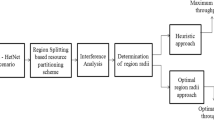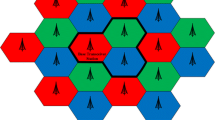Abstract
Long Term Evolution—Advanced (LTE-A) is the most widely used and encouraging technology for 4G and 5G mobile networks. The LTE technology in wireless networks has achieved a significantly high throughput because it makes use of multiple access schemes. We propose an iterative heuristic optimal resource allocation (HORA) algorithm and a chunk based resource block allocation (CRBA) scheduling algorithm to determine resource block (RB) allocation among users to satisfy the quality of service requirement. A heuristic approach which is used in HORA offers a tradeoff between computational complexity and performance. It performs RB and power allocation separately to reduce computational complexity. In the CRBA algorithm sets of RBs are allocated to groups of users keeping power constant to all users. User selection is performed based on channel conditions to improve throughput. RB allocation is an additive method to maximize the data transmission rate and energy efficiency. The use of channel quality indicator feedback from the user equipment (UE) to eNodeB plays an important role in the selection of appropriate modulation and coding schemes and benefits the assigned chunk of RBs to users in the wideband channel-dependent selective frequency-time domain. Here, RB usage and quality-of-service (QoS) constraint are considered for the scheduling algorithm. The HORA algorithm assigns most RBs to users who have high-value signal to noise ratio and continues the RB allocation until it meets the QoS criteria of all users in consideration of the threshold value of the power budget. Problems that arise during continuous resource allocation to the scheduled user are considered as APX-hard and NP-hard problems. An RB and power allocation optimization problem is formulated for the maximum data rate in the cellular network. The simulation results show that the proposed approaches demonstrate considerable throughput improvement at the user end in a significant and robust condition.













Similar content being viewed by others
References
Mousavi, H., Amiri, I. S., Mostafavi, M. A., & Choon, C. Y. (2019). LTE physical layer: Performance analysis and evaluation. Applied computing and informatics, 15(1), 34–44
Abdelsadek, M. Y., Gadallah, Y., & Ahmed, M. H. (2019). Matching-based resource allocation for critical MTC in massive MIMO LTE networks. IEEE Access, 7, 127141–127153
Monikandan, B. S., Sivasubramanian, A., Babu, S. P. K., Venkatesan, G. P., & Arunachalaperumal, C. (2020). Channel aware optimized proportional fair scheduler for LTE downlink. Peer-to-Peer Networking and Applications, 13, 1–10
Aijaz, A., Chu, X., & Aghvami, A. H. (2014). Energy efficient design of SC-FDMA based uplink under QoS constraints. IEEE Wireless Communications Letters, 3(2), 149–152
Triantafyllopoulou, D., Kollias, K., & Moessner, K. (2015). QoS and energy efficient resource allocation in uplink SC-FDMA systems. IEEE Transactions on Wireless Communications, 14(6), 3033–3045
Kabir, M. T., & Masouros, C. (2020). Delay-constrained beamforming and resource allocation in full duplex systems. IEEE Transactions on Vehicular Technology, 69(3), 3476–3480
Noliya, A., & Kumar, S. (2020). Performance analysis of resource scheduling techniques in homogeneous and heterogeneous small cell LTE-A networks. Wireless Personal Communications, 112, 1–30
Mardani, M. R., & Ghanbari, M. (2019). Robust resource allocation scheme under channel uncertainties for LTE-A systems. Wireless Networks, 25(3), 1313–1325
Da Mata, S. H., & Guardieiro, P. R. (2017). Resource allocation for the LTE uplink based on genetic algorithms in mixed traffic environments. Computer Communications, 107, 125–137
De La Fuente, A., Femenias, G., Riera-Palou, F., & Armada, A. G. (2018). Subband CQI feedback-based multicast resource allocation in MIMO-OFDMA networks. IEEE Transactions on Broadcasting, 64(4), 846–864
Du, J., Zhao, L., Feng, J., Xin, J., & Wang, Y. (2016). Enhanced PSO based energy-efficient resource allocation and CQI based MCS selection in LTE-A heterogeneous system. China Communications, 13(11), 197–204
Kumar, V., & Mehta, N. B. (2019). Modeling and analysis of differential CQI feedback in 4G/5G OFDM cellular systems. IEEE Transactions on Wireless Communications, 18(4), 2361–2373
Chang, C. H., Chao, H. L., & Liu, C. L. (2011). Sum throughput-improved resource allocation for LTE uplink transmission. In 2011 IEEE Vehicular Technology Conference (VTC Fall) (pp. 1–5). IEEE.
Khamidehi, B., & Sabbaghian, M. (2017). Resource allocation for SC-FDMA femtocell networks. IEEE Transactions on Vehicular Technology, 68(5), 4573–4585
Baskaran, S. B. M., Raja, G., Bashir, A. K., & Murata, M. (2017). QoS-aware frequency-based 4G+ relative authentication model for next generation LTE and its dependent public safety networks. IEEE Access, 5, 21977–21991
Kim, S. H., & Kim, J. (2019). An opportunistic MCS drop scheme for improved LTE eMBMS transmission. Wireless Personal Communications, 107(3), 1431–1442
Lee, Y. L., Loo, J., & Chuah, T. C. (2016). Dynamic resource management for lte-based hybrid access femtocell systems. IEEE Systems Journal, 12(1), 959–970
Dechene, D. J., & Shami, A. (2012). Energy-aware resource allocation strategies for LTE uplink with synchronous HARQ constraints. IEEE Transactions on Mobile Computing, 13(2), 422–433
Femenias, G., Riera-Palou, F., & Thompson, J. S. (2016). Robust scheduling and resource allocation in the downlink of spatially correlated MIMO-OFDMA wireless systems with imperfect CSIT. IEEE Transactions on Vehicular Technology, 65(2), 614–629
Ragaleux, A., Baey, S., & Karaca, M. (2017). Standard-compliant LTE-A uplink scheduling scheme with quality of service. IEEE Transactions on Vehicular Technology, 66(8), 7207–7222
Palit, B., & Das, S. S. (2020). A cross layer framework of radio resource allocation for QoS provisioning in multi-channel fading wireless networks. Wireless Networks, 26(1), 403–419
Wang, C., Huang, J. J., & Su, C. Y. (2015). Buffer-aware and delay-sensitive resource allocation in the uplink of 3GPP LTE networks. Wireless Personal Communications, 84(3), 1877–1890
Ruby, R., Leung, V. C., & Michelson, D. G. (2014). Uplink scheduler for SC-FDMA-based heterogeneous traffic networks with QoS assurance and guaranteed resource utilization. IEEE Transactions on Vehicular Technology, 64(10), 4780–4796
Chaudhuri, S., Baig, I., & Das, D. (2015). Utility based QoS aware uplink scheduler scheme for LTE small cell network. In 2015 IEEE International Conference on Communications (ICC) (pp. 3149–3154). IEEE.
Thayammal, M. C., & Mary Linda, M. (2019). Utility-based optimal resource allocation in LTE-A networks by hybrid ACO-TS with MFA scheme. The Computer Journal, 62(6), 931–942
Prasad, N., Zhang, H., Zhu, H., & Rangarajan, S. (2012). Multiuser scheduling in the 3GPP LTE cellular uplink. IEEE Transactions on Mobile Computing, 13(1), 130–145
Afif, M., Hassen, W. B., & Tabbane, S. (2019). A resource allocation algorithm for throughput maximization with fairness increase based on virtual PRB in MIMO-OFDMA systems. Wireless Networks, 25(3), 1083–1097
Piro, G., Grieco, L. A., Boggia, G., Capozzi, F., & Camarda, P. (2010). Simulating LTE cellular systems: An open-source framework. IEEE transactions on vehicular technology, 60(2), 498–513
Wu, X., Ma, Z., Chen, X., Labeau, F., & Han, S. (2019). Energy efficiency-aware joint resource allocation and power allocation in multi-user beamforming. IEEE Transactions on Vehicular Technology, 68(5), 4824–4833
Lim, J. H., Ahmad, B., Jusoh, M., & Sabapathy, T. (2017). Deployment of Resource Allocation and Power Control Schemes in Long Term Evolution Advanced (LTE-A) Hybrid Network. Wireless Personal Communications, 96(2), 2943–2963
Lu, X., Ni, Q., Li, W., & Zhang, H. (2017). Dynamic user grouping and joint resource allocation with multi-cell cooperation for uplink virtual MIMO systems. IEEE Transactions on Wireless Communications, 16(6), 3854–3869
Lunttila, T., Lindholm, J., Pajukoski, K., Tiirola, E., &Toskala, A. (2007). EUTRAN uplink performance. In 2007 2nd International Symposium on Wireless Pervasive Computing. IEEE.
Kukade, S. Y., Sutaone M. S., & Patil R. A. (2021). Evaluation of SC-FDMA Physical Link Using USRP. Advances in Communication and Computational Technology. Springer, Singapore (pp. 1003–1017).
Baker, M. (2009, December). LTE-Advanced physical layer. In Proc. IMT-Advanced Evaluation Workshop, 3GPP, Beijing (pp. 1–48).
Wang, M., Zhang, J., Ren, B., Yang, W., Zou, J., Hua, M., & You, X. (2015). The evolution of LTE physical layer control channels. IEEE Communications Surveys and Tutorials, 18(2), 1336–1354
Razavi, S. M., & Ratnarajah, T. (2016). Adaptive LS- and MMSE-based beamformer design for multiuser MIMO interference channels. IEEE Transactions on Vehicular Technology, 65(1), 132–144
Guo, W., Fan, J., Li, G. Y., Yin, Q., & Zhu, X. (2016). Adaptive SU/MU-MIMO scheduling schemes for LTE-A downlink transmission. IET Communications, 11(6), 783–792
ETSI TS 136 213 V15.2.0, LTE; Evolved Universal Terrestrial Radio Access (E-UTRA); Physical layer procedures (3GPP TS 36.213 version 15.2.0 Release 15), (2018–10).
Author information
Authors and Affiliations
Corresponding authors
Additional information
Publisher's Note
Springer Nature remains neutral with regard to jurisdictional claims in published maps and institutional affiliations.
Rights and permissions
About this article
Cite this article
Kukade, S., Sutaone, M. & Patil, R. Optimal performance of resource allocation in LTE-A for heterogeneous cellular network. Wireless Netw 27, 3329–3344 (2021). https://doi.org/10.1007/s11276-021-02635-w
Accepted:
Published:
Issue Date:
DOI: https://doi.org/10.1007/s11276-021-02635-w




